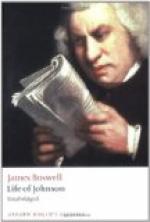M’Leod of Ulinish had come in the afternoon. We were a jovial company at supper. The Laird, surrounded by so many of his clan, was to me a pleasing sight. They listened with wonder and pleasure, while Dr. Johnson harangued. I am vexed that I cannot take down his full strain of eloquence.
WEDNESDAY, SEPTEMBER 15.
The gentlemen of the clan went away early in the morning to the harbour of Lochbradale, to take leave of some of their friends who were going to America. It was a very wet day. We looked at Rorie More’s horn, which is a large cow’s horn, with the mouth of it ornamented with silver curiously carved. It holds rather more than a bottle and a half. Every Laird of M’Leod, it is said, must, as a proof of his manhood, drink it off full of claret, without laying it down. From Rorie More many of the branches of the family are descended; in particular, the Talisker branch; so that his name is much talked of. We also saw his bow, which hardly any man now can bend, and his Glaymore>, which was wielded with both hands, and is of a prodigious size. We saw here some old pieces of iron armour, immensely heavy. The broadsword now used, though called the Glaymore, (i.e. the great sword) is much smaller than that used in Rorie More’s time. There is hardly a target now to be found in the Highlands. After the disarming act[591], they made them serve as covers to their butter-milk barrels; a kind of change, like beating spears into pruning-hooks[592].
Sir George Mackenzie’s Works (the folio edition) happened to lie in a window in the dining room. I asked Dr. Johnson to look at the Characteres Advocatorum. He allowed him power of mind, and that he understood very well what he tells[593]; but said, that there was too much declamation, and that the Latin was not correct. He found fault with appropinquabant[594], in the character




